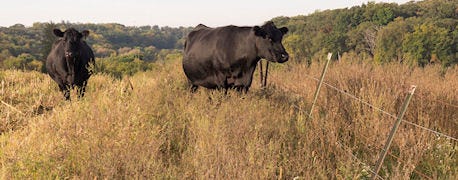April 28, 2015

By Ryan Sterry
Much of the focus for beef cattle reproduction programs is on breeding cows in a timely fashion and narrowing the range of the calving window.
Related: 5 Traits You Want in a Beef Breeding Heifer
There's no getting around the fact that excessive days open, and open cows at calving season, cause considerable financial losses for beef producers. Narrowing the calving window reduces variation in calf age, thus helping to produce a more uniform calf crop at market time.

Open cows at calving season cause considerable financial losses for beef producers. Is it worth it to switch open cows over to a fall calving season?
But sometimes things don't go according to plan, especially when it comes to reproduction. A new twist to this old problem is the low inventory of the national beef cow herd, which in many markets is placing a premium on pregnant cows and heifers.
Lower cow inventories may bring about the temptation to try one more time on those cows that didn't conceive during your normal breeding season -- but extending the breeding season will have the carry over effect of transitioning a portion of the herd from spring or summer calving to a fall calving season.
Considerations for fall calving
If you are considering breeding cows for a fall calving season, an early pregnancy diagnosis strategy is a must. Having a timely pregnancy check in place for the herd will give you the option of quickly re-breeding open cows or culling them. Those cows conceiving to the later breeding could be alternatively marketed as pregnant fall calving cows, or retained in your herd.
A University of Nebraska Extension article by Rick Rasby highlights the considerations of whether or not open cows should be exposed again for breeding or culled.
Take into consideration these factors when determining the fate of an open cow:
• age of the cow
• calving problems
• udder and other structural problems
• disposition
• ability/inability to care for a calf
Even if you have the ability to re-breed open cows, consideration should still be given to culling cows with these faults.
More questions for beef producers >>
Planning for all possibilities is the best way to prepare for a successful calving season. But do it right! Download our free report, Best Practices for a Successful Calving Season, to ensure you have everything in place to limit stress on you and your herd.
~~~PAGE_BREAK_HERE~~~
Do the economics of fall calving pencil out?
A partial budget is highly recommended to help make the decision to extend the breeding and calving season for your particular farm.
A partial budget should account for added revenue, added expenses, and any decreases in revenue or expenses from making the change to a fall calving season.
First ask yourself some questions. If you are going to market cows as fall calving, is there enough of a price difference between pregnant fall calving cows and cull cows to justify the added expense? Do your traditional markets look for fall calving cows, or will you have to do research to find an alternative market?
If you are going to retain cows for fall calving, a partial budget is even more important. Along with the financial implications, it will mean significant management changes such as the time and labor of an added fall calving season, and managing nursing cows and calves through a winter environment.
Fall cattle care consderations include:
• Snow, ice, and mud are winter realities in many climates, and you need to be prepared for how you will get mother and calf through them.
• Managing the nutrition of the fall calving herd is another consideration. Remember, fall calving cows will still be nursing calves through the winter and will require a higher plane of nutrition than our typical winter dry cow rations provide.
• An honest assessment of feed and forage is required. Assess if winter forage is available, the cost of necessary purchased feeds, and your ability to more intensively manage nutrition is a must.
• Adequate facilities to keep those animals clean and dry is required.
Marketing calves
There is a potential upside though to look at. Fall-born calves can be marketed as feeders in early spring, a time at which feeder calf prices typically rising and there are fewer calves on the market to compete with.
Related: Beat this calf disease by using the Sandhills Calving System
Or, if you have adequate availability of pasture, calves can be retained and grazed through the summer and marketed in the fall as yearlings. Depending on your operation, fall calving cows have summer pastures to recuperate on and regain condition. Also, fall calving cows will be bred again before the heat of summer.
A more detailed listing of the considerations for the fall calving beef herd can be found in the Michigan State Extension article "Fall Calving fits Michigan's Climate for Beef Cow/Calf Herds," by Frank Wardynski.
Sterry is the St. Croix County Extension agriculture agent in Wisconsin
You May Also Like




